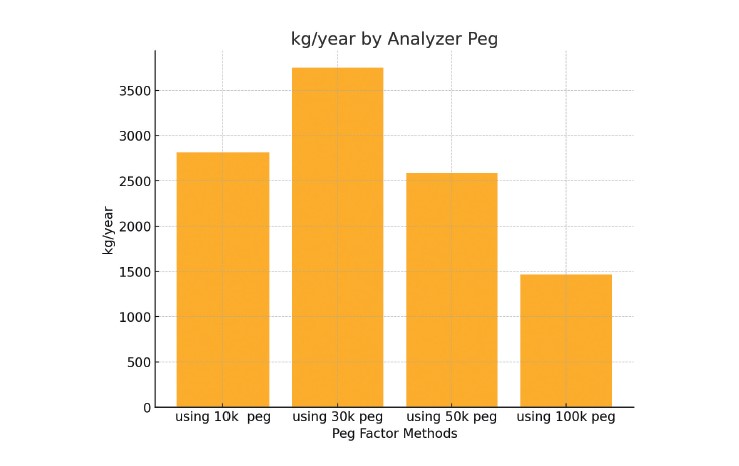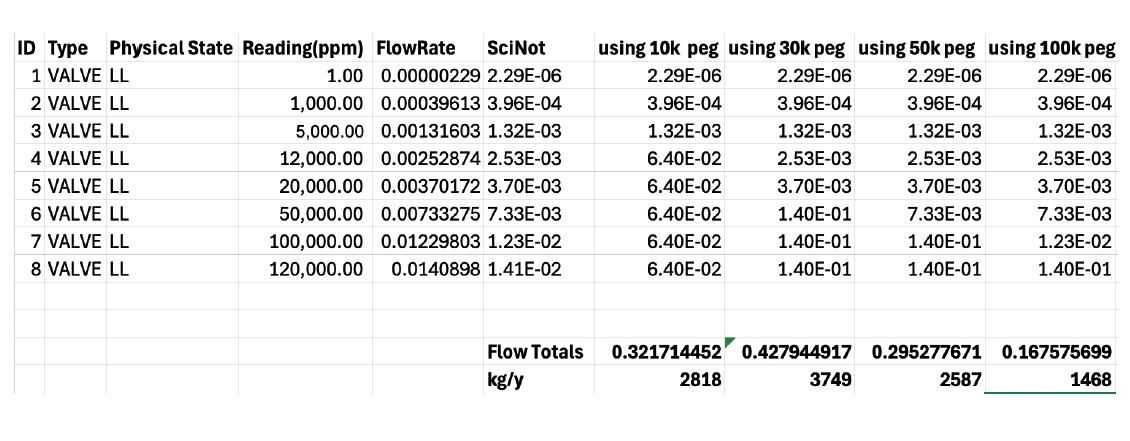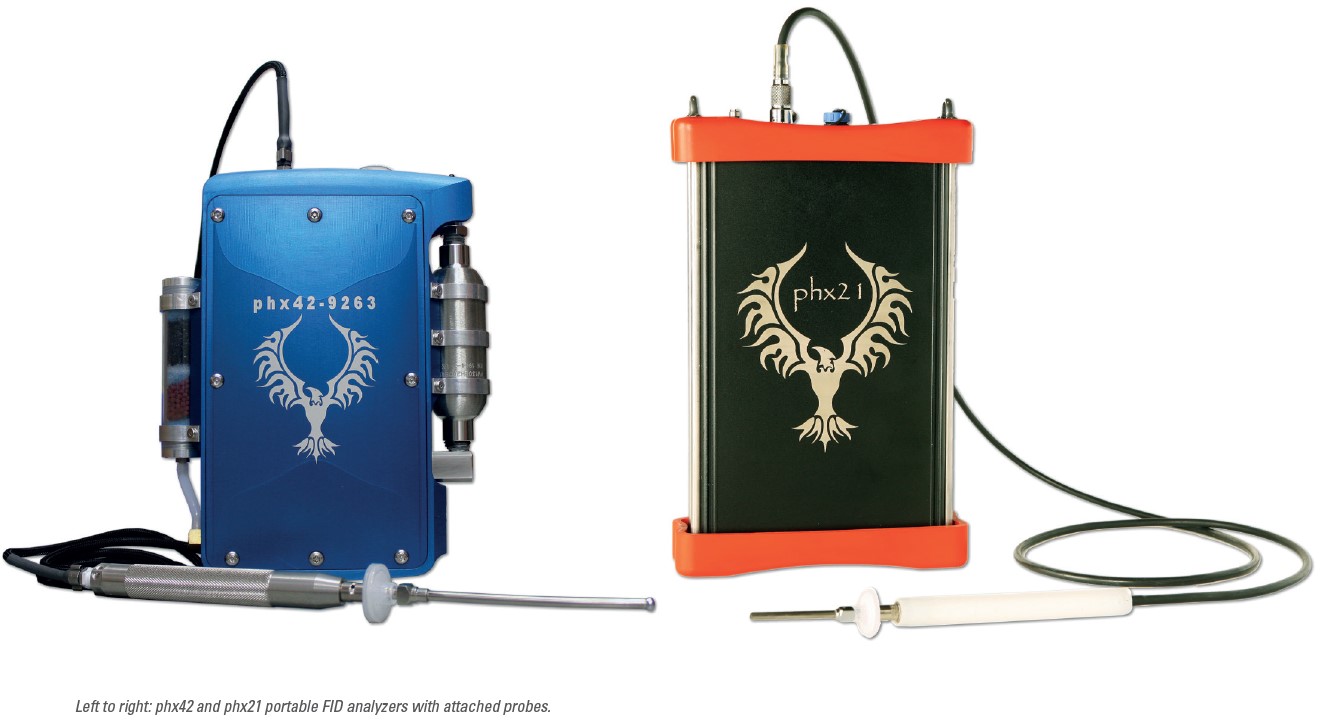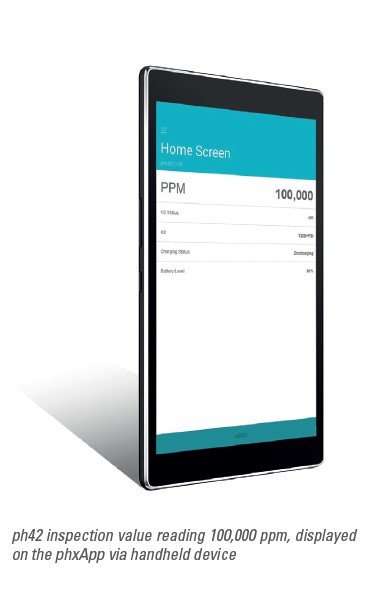This article will outline the options available to LDAR (Leak Detection and Repair) programs regarding pegged emission rates and analyzers, focusing on valves in light liquid/gas vapor service. The information is prepared solely for your consideration. LDARtools does not provide regulatory advice or guidance.
By Kevin Moses, Director of Operations – LDARTools
Definitions and Background
Pegged Emission Rate – The specified emission rate used for any leak with a “pegged” screening value (i.e., any PPM reading that exceeds the Analyzer Peg Value).
Analyzer Peg Value – The highest PPM reading that an analyzer is designed to detect.
When a PPM reading is higher than the Analyzer Peg – “The instrument measurement may exceed the scale of the instrument, referred to as a ‘pegged’ readout. For several instruments, the highest readout on the scale is 10,000 ppmv. For generating an emissions estimate, a dilution probe should be employed to measure concentrations greater than the instrument’s normal range unless average emission factors for greater than or equal to the ‘pegged’ readout are applied. Extending the measurement range necessitates calibrating the instrument to the higher concentrations.” (From section 2.3.3 of the 1995 Protocol for Equipment Leak Emission Estimates).
Calculation of Emissions Using Correlation Equation
To estimate emissions using the EPA Correlation Approach, measured concentrations (screening values in PPM) for each component are individually calculated by applying the PPM reading to a specific Correlation Equation, specified for that component type and physical state.
How it works: There are three possible scenarios in calculating emission for a specific Component.
- If there is no actual inspection available (represented in PPM), then you must use the Average Emission Factors provided by the EPA for the component type and physical state.
- If there is an inspection available (represented in PPM), and the PPM reading is lower than the Analyzer Peg Value, then you must use the specific Correlation Equation provided by the EPA for that component type and physical state.
- If there is an inspection available (represented in PPM) and the PPM reading is equal to or greater than the Analyzer Peg Value, then you must use the Pegged Emission Rate for that component type and physical state. This Pegged Emission Rate inevitably results in a significantly higher emission rate than would the Correlation Equation calculation (#2, above).
For an analyzer with an Analyzer Peg Value of 10,000 PPM, any reading above 10,000 ppm can be easily calculated using the 10k PPM Pegged Emission Rate. Similarly, for an analyzer that pegs at 100k, use the 100k Pegged Emission Rate (potentially subject to the calibration requirements below).

Considerations for Different Analyzer Peg Values
If you have an analyzer with an Analyzer Peg Value of 30k or 50k, it would be prudent to use the correlation equation up until that pegged value, and then use the 100k pegged value above it. However, this approach may result in an increase in reported emissions.
Example: Using an analyzer with a 30k pegged emission rate:
- PPM value is 30,001 (a pegged reading).
- 100k emissions factor converted back to ppm is 2.6 million ppm.
- If using a 10k ppm analyzer peg, emissions reported would be about 912,000 ppm.
Converting mass back to ppm is not considered best practice, but is used here for illustration purposes.
Increased accuracy of reporting for components leaking between 10k and the analyzer peg value is a benefit of using a 30k or 50k analyzer peg, but pegged values could significantly increase reported emissions.
Questions
Do you need to calibrate to the Analyzer Pegged Value? Maybe. The 1995 Protocol states: “The instrument measurement may exceed the scale of the instrument, referred to as a ‘pegged’ readout. A dilution probe should be employed for concentrations beyond the instrument’s normal range unless average emission factors for greater than or equal to the ‘pegged’ readout are applied. Extending the measurement range necessitates calibrating the instrument to higher concentrations.”
Since “higher concentrations” are not defined, one interpretation is to use the highest available concentration for calibration, which for methane is ~25k ppm in air (above which it becomes explosive).
Another option is to have a factory calibration done annually at 100,000 ppm. This calibration would persist during routine daily calibration.
What is my Analyzer Peg Value? The 1995 Protocol was developed with analog analyzers that could not exceed the meter dial’s printing. Modern analyzers use dynamic ranging to extend he upper limit significantly, but accuracy and linearity above 10,000 ppm (except for phx42) are uncertain, especially without higher value calibration.
The 2011 & 2015 Protocols state: “If the monitoring instrument measures concentrations only up to 10,000 ppmv or 100,000 ppmv, the applicable values for pegged emission rates in Table 2-2 are used to estimate emissions.”


Factors Determining Max Reliable PPM
- Hardware on the Circuit Board: This chip reads minimal current from the detector. Better accuracy at low ppms generally means a lower max reading before saturation. Analyzers impacted: All.
- Software Controlled Max PPM Value: Possible for phx42 but not implemented.
- Lack of O2 to Maintain Flame: For sample pumps providing combustion air (assuming methane), the limit is ~50k ppm. Linearity is impacted below this, and calibration to a higher value like 25k ppm can somewhat correct for this for values below the calibration point. Analyzers impacted: PHX21, TVA1000b, and TVA2020.
- Detector Temperature Max: Prevents Teflon inside the detector from overheating; this only applies to phx42. The limit will not initiate shutdown until well over 100k ppm for some time.
Specifications from Common Manufacturers (as of 07/29/24)
TVA1000b:
- Dynamic Range: 5-2,000 ppm (PID) isobutylene; 0.5-50,000 ppm (FID) methane
- Linear Range: 5-500 ppm (PID) isobutylene; 0.5-10,000 ppm (FID) methane
TVA2020:
- FID Instrument: ±10% of reading or ±1.0 ppm, from 1.0 to 10,000 ppm
- Dynamic Range: 5-2,000 ppm (PID) isobutylene; 0.5-50,000 ppm (FID) methane
- PID Instrument: ±20% of reading or ±0.5 ppm, from 0.5 to 500 ppm
- Concentration: FID: 0-30,000 ppm (methane); PID: 0-2,000 ppm (isobutylene)
PHX21:
- Range: 0-50,000 ppm Methane
phx42:
- Range: 0-100,000+ ppm Methane
- When calibrated to Zero and 25,000ppm Methane, 15% accuracy is maintained at 100,000ppm.
- Annual Factory Calibration is available for 100,000ppm. A factory calibration will not be overwritten by daily calibrations in the lower spans.
- Higher linear performance due to combustion air scrubber and second pump preventing oxygen displacement in combustion air.

Conclusion
End Users must determine the digital equivalent to “off scale,” “measures,” and the necessary calibration requirements. These decisions will determine what to select for your Analyzer Peg Factor.


